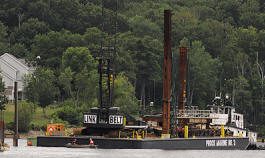Rig readied for Penobscot dredging

Prock Marine of Rockland has been hired to remove 11,000 to 12,000 cubic yards of earth from the riverbed, Tom Ruksznis, Cianbro project manager for site development, said Tuesday.
“They’ve been hired to do two things,” he said. “They’re going to do the dredging that starts August 1 and they have been hired to install two dolphins.”
The dolphins are tie-down points for the barges and are constructed by driving three massive steal pilings into the soil at the deep-water bulkhead, he said.
Cianbro Corp., a Pittsfield construction company known around the state and the nation, has a multimillion-dollar contract to construct 52 building modules — prefabricated, self-standing building skeletons — for a refinery expansion project in Texas.
The frames of the first set of refinery modules now are visible at the site. Once finished, they will be shipped out by barge and put together on-site at the Motiva Port Arthur Refinery, which is in the middle of a $7 billion expansion that will make the facility the largest crude oil processing plant in North America.
Dredging the river was required to make room for the heavy barges that will transport the building modules, which can be as tall as five stories and weigh up to 1,200 tons.
“We excavated approximately 5,000 cubic yards last winter before the February 28 deadline, and put it on the site” as fill, Ruksznis said.
Most of the January and February dredging was done from the riverbank using two huge cranes. The newly excavated materials also will be reused on the 41-acre riverfront locale, he said.
The break in the excavation was required to avoid a possible adverse impact on native fish, including short-nosed sturgeon and Atlantic salmon.
“We’ll have approximately 10 feet of water depth at low tide once we’re done dredging,” Ruksznis said. “Before we started last fall, there was exposed soil at low tide at the corner where we put in the bulkhead. It was 1 to 2 feet. Most of the dredged area is underwater all the time.”
Cianbro and its subcontractors have worked since fall to change the defunct Eastern Fine Paper Co. mill site, which closed in 2004, into a modular manufacturing facility.
“That’s [the dredging] really the only remaining work we have to do for site development,” Ruksznis said.
A copyright article from the Bangor Daily News, July 23, 2008.

